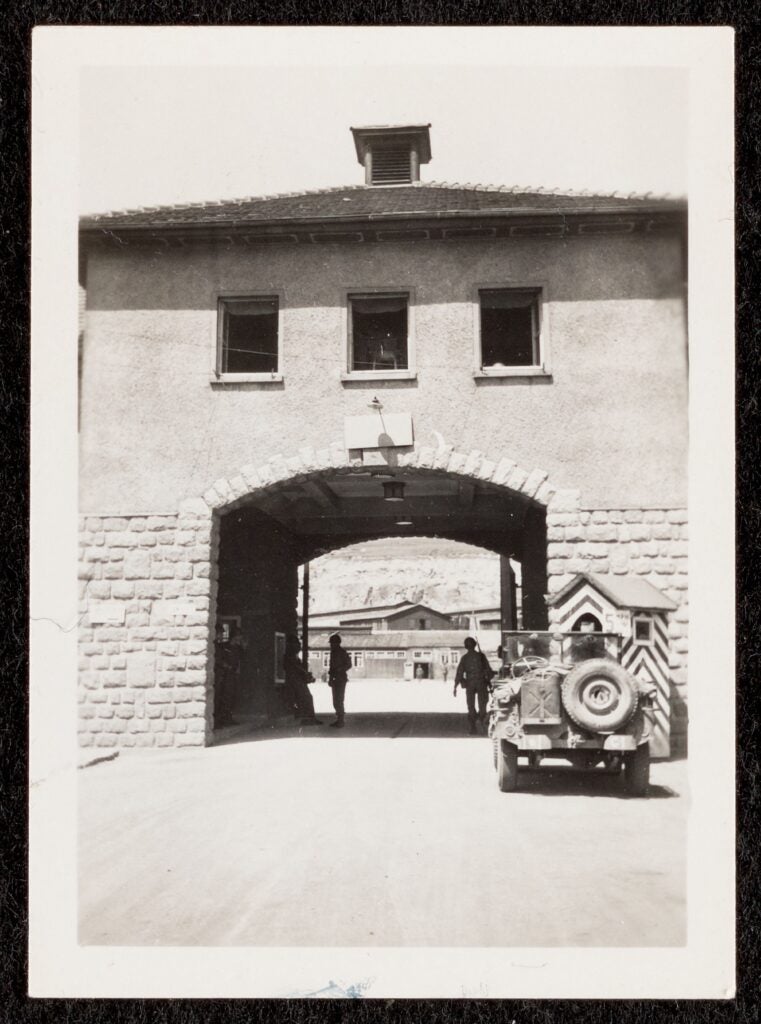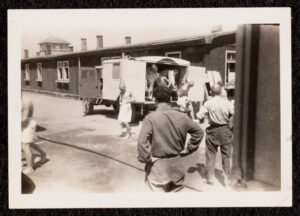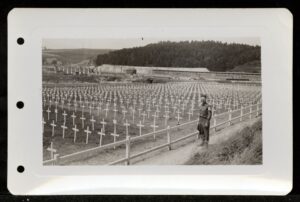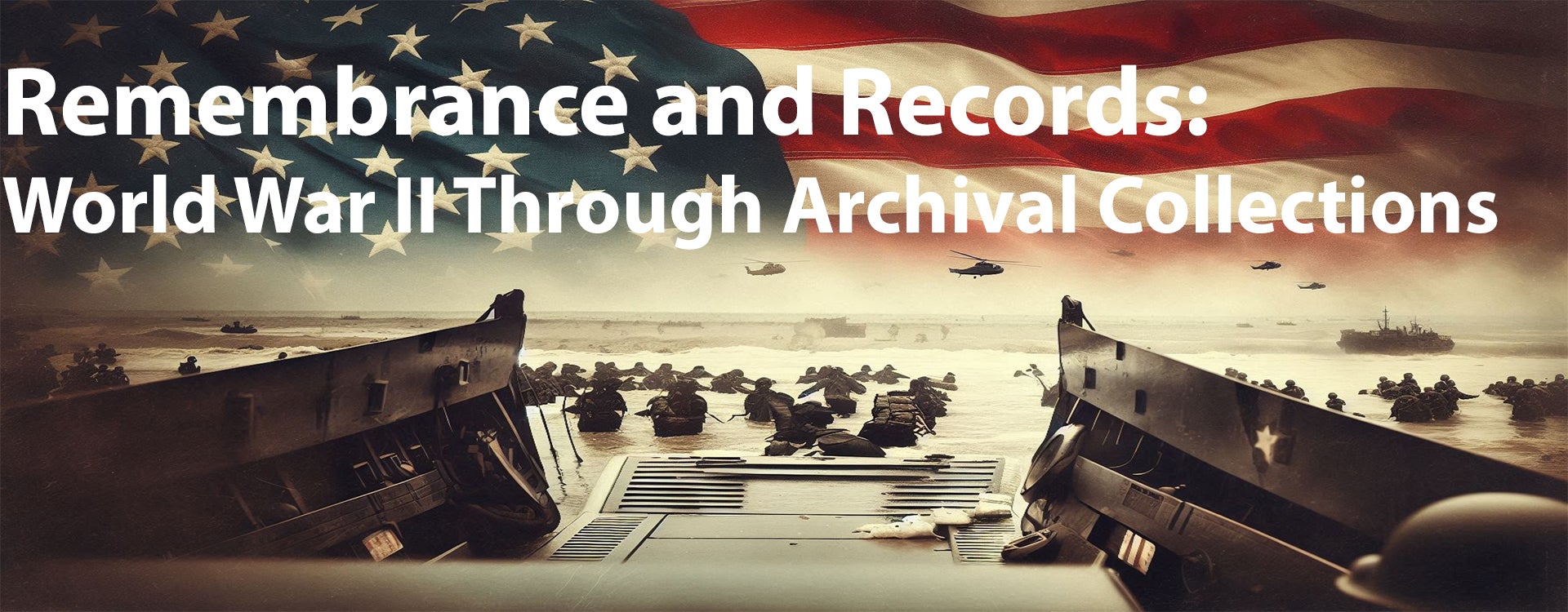The Liberation of Nazi Concentration Camps at the End of World War II
Remembrance and Records: World War II Through Archival Collections
Warning: The following content features accounts of war and human suffering. Content may be upsetting to some.
Over the next year, in commemoration of the 80th anniversary of the end of World War II, Joyner Library Special Collections will be highlighting items from the East Carolina Manuscripts Collection that relate to the conflict and the individuals who served.
As World War II neared its end in Europe in early 1945, Allied forces advancing from both the east and west encountered one of the most harrowing aspects of Nazi brutality—the concentration and extermination camps.1 These camps, designed to imprison, exploit, and ultimately exterminate millions of people, primarily Jews but also political prisoners, Romani people, and other persecuted groups, were discovered in various stages of operation or abandonment.2 The liberators, including American, British, Soviet, and Canadian troops, discovered skeletal survivors, mass graves, and evidence of systematic genocide.3 The liberation of these camps marked not only the end of the Holocaust but also the beginning of a long and painful recovery process for the survivors.4 Additionally, the evidence found during the liberation of the camps would play an important role in prosecuting Nazi soldiers at the Nuremberg Trials.5
The Liberation of the Camps

Entrance to Gusen I Concentration Camp, near Mauthausen, Austria, after being cleaned up by U.S. Army, 1945. Image from Alvis Mewborn Papers (#1159), East Carolina Manuscript Collection, J. Y. Joyner Library, East Carolina University, Greenville, North Carolina, USA.
The first major camp to be liberated was Majdanek, located near Lublin, Poland, in July 1944. The rapid Soviet advance caught the Nazis off guard, and much of the camp remained intact, providing clear evidence of mass murder.6 Auschwitz, the largest and most infamous extermination camp, was liberated by the Red Army on January 27, 1945. Soviet troops found approximately 7,000 survivors, along with vast amounts of evidence—gas chambers, crematoria, and warehouses filled with the personal belongings of the victims.7 As the Western Allies advanced through Germany in the spring of 1945, they uncovered additional concentration camps.8 The U.S. Army liberated Buchenwald (April 11), Dora-Mittelbau (April 11), and Dachau (April 29), among others.9 British forces reached Bergen-Belsen on April 15, finding over 60,000 prisoners suffering from starvation and disease.10 The horrors witnessed in these camps left deep impressions on the liberators, some of whom documented their experiences to ensure that the world would never forget.11
The Humanitarian Crisis
Liberation did not mean immediate relief for survivors.12 Many were too weak to eat solid food, and disease spread rapidly in the overcrowded, unsanitary conditions.13 Allied medical personnel faced enormous challenges in treating thousands of malnourished and diseased individuals.14 Typhus outbreaks, in particular, claimed many lives even after liberation.15 Military doctors, nurses, and relief organizations worked tirelessly to save as many lives as possible.16 For many survivors, freedom came with the realization that they had lost their entire families.17 Displaced persons camps were established to provide temporary shelter and international efforts were made to help survivors rebuild their lives.18 The United Nations Relief and Rehabilitation Administration (UNRRA) played a crucial role in assisting displaced persons, though many faced continued hardships and struggled to find permanent homes.19
The Liberation of Mauthausen and the Role of the 131st Evacuation Hospital

Survivors of Gusen I Concentration Camp receiving medical care, 1945. Image from Alvis Mewborn Papers (#1159), East Carolina Manuscript Collection, J. Y. Joyner Library, East Carolina University, Greenville, North Carolina, USA.
One of the last major concentration camps to be liberated was Mauthausen, located in Austria.20 Unlike the infamous camps of Auschwitz or Bergen-Belsen, Mauthausen was classified as a “Category III” camp, meaning the camp would only hold prisoners whom the Reichssicherheitshauptamt, or Reich Main Office for Security (RSHA) deemed “severely incriminated, especially previously convicted criminals and those that were deemed to be associated with criminals.21 It housed political prisoners, resistance fighters, Jewish citizens, and other groups deemed enemies of the Nazi regime.22
Mauthausen was established in 1938 following the Anschluss (Germany’s annexation of Austria) and became the center of a network of subcamps.23 The camp was notorious for its brutality, particularly in the Wiener Graben quarry, where prisoners were forced to carry heavy stones up the “Stairs of Death.”24 Many prisoners were worked to exhaustion, beaten, or outright executed.25 As the Allies closed in, the Nazis attempted to destroy evidence of their crimes, forcing prisoners on death marches and evacuating records.26 However, thousands of prisoners remained in the camp when the 11th Armored Division of the U.S. Third Army arrived on May 5, 1945.27
The 11th Armored Division’s Role
The 11th Armored Division, part of General George S. Patton’s Third Army, played a critical role in the liberation of Mauthausen.28 As they moved into Austria, soldiers encountered refugees and heard reports of atrocities at the camp.29 Upon arrival, they found thousands of emaciated prisoners, many too weak to walk.30 The initial response of the liberators was a mix of shock and swift action.31 Soldiers provided food and medical care to survivors, although some initially overfed prisoners, unintentionally causing harm to their fragile digestive systems.32 Military personnel documented the conditions with photographs and testimonies, ensuring that the crimes committed at Mauthausen would not be forgotten.33
Survivor Stories from Mauthausen
Survivors of Mauthausen have provided harrowing accounts of their experiences.34 One such survivor, Simon Wiesenthal, who later became a famed Nazi hunter, was among those liberated at the camp.35 He had endured years of forced labor and near-starvation but survived to seek justice for those who had perished.36 Another survivor, Francisco Boix, a Spanish Civil War refugee, was forced to work in the camp’s photography lab, where he secretly saved incriminating photographs of SS officers and camp conditions.37 These photographs would later serve as crucial evidence in the Nuremberg Trials.38 Eliezer Adler, a Jewish survivor, recalled the arrival of American troops: “I could barely lift my head, but I saw them—they looked like angels. I had not seen kindness in years, and suddenly there was warmth and hope.”39 Adler’s story, like many others, highlights the shared experiences of those who suffered in Mauthausen.40
The Work of the 131st Evacuation Hospital
The 131st Evacuation Hospital, a U.S. Army medical unit, was among the first medical teams to enter Mauthausen.41 Their primary task was to stabilize survivors, many of whom were suffering from starvation, typhus, and other diseases.42 The sheer scale of the crisis overwhelmed medical staff with limited supplies and personnel.43 Efforts to rehydrate and nourish survivors were complicated because their bodies could not process regular food.44 Special diets were introduced to help them regain strength, and makeshift hospitals were set up within the camp.45 The 131st Evacuation Hospital worked alongside other medical units, including captured German doctors and nurses, to treat thousands of patients. 46
The Persecution of Nazi Soldiers

Photograph of a soldier standing beside the cemetery at Camp Gusen Concentration Camp in Gusen, Austria, taken by Alvis Mewborn during his service in the U. S. Army in World War II. Image from Alvis Mewborn Papers (#1159), East Carolina Manuscript Collection, J. Y. Joyner Library, East Carolina University, Greenville, North Carolina, USA.
Following the war, many of the Nazi soldiers and camp officials responsible for the atrocities at Mauthausen were prosecuted. The Mauthausen-Gusen Trials, held between 1946 and 1947, convicted numerous SS officers, guards, and collaborators of war crimes.48 Some, such as Franz Ziereis, Mauthausen’s commandant, were killed or committed suicide before they could stand trial.49 Others were executed or sentenced to long prison terms.50 The trials were instrumental in setting legal precedents for crimes against humanity and reinforcing the importance of justice for the victims of the Holocaust.51 However, many perpetrators managed to escape justice, blending into post-war society or fleeing to other countries. 52 Following the war, many of the Nazi soldiers and camp officials responsible for the events at Mauthausen were prosecuted.47 The Mauthausen-Gusen Trials held between 1946
Alvis Mewborn and His Service
One of the soldiers serving in the 131st Evacuation Hospital was Alvis Whitted Mewborn, a North Carolina native who enlisted in the U.S. Army on October 21, 1941.53 Mewborn served as a Master Sergeant and was stationed at Camp Gusen I, a subcamp of Mauthausen, from April to November 1945.54 During his time at the camp, Mewborn helped provide medical care, food, clothing, and proper burials for those who perished.55 The 131st Evacuation Hospital built a cemetery and chapel as part of their efforts to bring dignity to the victims.56 He also documented the experience, photographing the camp, its survivors, and surrounding towns such as Ulm, Enns, and even the bombed remains of Hitler’s and Goering’s residences in Berchtesgaden.57 His photographs of the war are available in the East Carolina Manuscript Collection as part of the Alvis Mewborn Papers (#1159).58
Conclusion
The liberation of Nazi concentration camps was a defining moment during the final months of World War II in Europe.59 It exposed the full extent of Nazi atrocities and brought long-overdue relief to countless survivors. The evidence uncovered not only documented the unimaginable suffering endured by millions but it also served as a foundation for the pursuit of justice through the Nuremberg Trials.60 Remembering the stories of survivors, liberators, and those who perished ensures that the lessons of the Holocaust remain a vital part of our collective memory.
Visit the Ship’s Log to learn more about materials related to World War II that are a part of the East Carolina Manuscripts Collection’s holdings. Joyner Library Special Collections will be displaying an exhibit of items and individual stories related to World War II during the summer and fall of 2025.
Sources
- Alvis Mewborn Papers (#1159). East Carolina Manuscript Collection, J. Y. Joyner Library, East Carolina University, Greenville, North Carolina, USA.
- Bergen, Doris L. War and Genocide: A Concise History of the Holocaust. Rowman & Littlefield, 2009.
- Boix, Francisco. “Testimony at the Nuremberg Trials.” Holocaust and War Crimes Archive, 1946.
- Fortunoff Video Archive for Holocaust Testimonies. Yale University. Accessed 2020. https://fortunoff.library.yale.edu/.
- Gilbert, Martin. The Holocaust: A History of the Jews of Europe During the Second World War. Holt, Rinehart and Winston, 1985.
- Imperial War Museums. “Concentration Camp Survivors Share Their Stories.” 2023. https://www.iwm.org.uk/history/concentration-camp-survivors-share-their-stories.
- “Liberation of Nazi Camps.” United States Holocaust Memorial Museum. Accessed n.d. https://www.ushmm.org.
- Loehrer, Gudrun, et al. “The Mauthausen Concentration Camp Complex: World War II and Postwar Records.” 2008.
- Mauthausen Memorial. “The Mauthausen Concentration Camp 1938–1945 – History – KZ-Gedenkstätte Mauthausen.” 2019. https://www.mauthausen-memorial.org/en/History/The-Mauthausen-Concentration-Camp-19381945.
- Neitzel, Sönke, and Harald Welzer. Soldaten: On Fighting, Killing, and Dying. Knopf, 2012.
- Reitlinger, Gerald. The SS: Alibi of a Nation, 1922–1945. Heinemann, 1953.
- “The 11th Armored Division During World War II.” United States Holocaust Memorial Museum. Accessed 2024. https://encyclopedia.ushmm.org/content/en/article/the-11th-armored-division.
- Trials of War Criminals Before the Nuremberg Military Tribunals Under Control Council Law No. 10. Washington, D.C.: U.S. Government Printing Office, 1951.
- S. Army. “Reports on Concentration Camp Liberations.” 1945.
- Wiesenthal, Simon. The Sunflower: On the Possibilities and Limits of Forgiveness. Schocken Books, 1969.
Notes
- “Liberation of Nazi Camps,” United States Holocaust Memorial Museum, accessed n.d., https://www.ushmm.org.
- “Liberation of Nazi Camps”
- “Liberation of Nazi Camps”
- “Liberation of Nazi Camps”
- Trials of War Criminals Before the Nuremberg Military Tribunals Under Control Council Law No. 10 (Washington, D.C.: U.S. Government Printing Office, 1951).
- “Liberation of Nazi Camps,” United States Holocaust Memorial Museum, accessed n.d., https://www.ushmm.org.
- Doris L. Bergen, “War and Genocide: A Concise History of the Holocaust” (Rowman & Littlefield, 2009).
- “Liberation of Nazi Camps,” United States Holocaust Memorial Museum, accessed n.d., https://www.ushmm.org.
- “Liberation of Nazi Camps”
- Martin Gilbert, “The Holocaust: A History of the Jews of Europe During the Second World War” (Holt, Rinehart and Winston, 1985).
- Imperial War Museums, “Concentration Camp Survivors Share Their Stories,” 2023, https://www.iwm.org.uk/history/concentration-camp-survivors-share-their-stories.
- “Liberation of Nazi Camps,” United States Holocaust Memorial Museum, accessed n.d., https://www.ushmm.org.
- “Liberation of Nazi Camps”
- “Liberation of Nazi Camps”
- “Liberation of Nazi Camps”
- S. Army, “Reports on Concentration Camp Liberations,” 1945.
- “Liberation of Nazi Camps,” United States Holocaust Memorial Museum, accessed n.d., https://www.ushmm.org.
- “Liberation of Nazi Camps”
- Sönke Neitzel and Harald Welzer, “Soldaten: On Fighting, Killing, and Dying” (Knopf, 2012).
- “Liberation of Nazi Camps,” United States Holocaust Memorial Museum, accessed n.d., https://www.ushmm.org.
- “Establishment of the Mauthausen Camp – KZ-Gedenkstätte Mauthausen,” n.d.
- Gerald Reitlinger, “The SS: Alibi of a Nation, 1922–1945” (Heinemann, 1953).
- “Establishment of the Mauthausen Camp – KZ-Gedenkstätte Mauthausen,” n.d.
- “Forced Labour in the Quarries – KZ-Gedenkstätte Mauthausen,” nd..
- Mauthausen Memorial, “The Mauthausen Concentration Camp 1938–1945 – History – KZ-Gedenkstätte Mauthausen,” 2019, https://www.mauthausen-memorial.org/en/History/The-Mauthausen-Concentration-Camp-1938-1945.
- “The Final Phase – KZ-Gedenkstätte Mauthausen,” n.d.
- “Liberation – KZ-Gedenkstätte Mauthausen,” n.d.
- “The 11th Armored Division During World War II,” United States Holocaust Memorial Museum, accessed 2024, https://encyclopedia.ushmm.org/content/en/article/the-11th-armored-division.
- “The 11th Armored Division During World War II”
- “The 11th Armored Division During World War II”
- “The 11th Armored Division During World War II”
- Gudrun Loehrer et al., “The Mauthausen Concentration Camp Complex: World War II and Postwar Records,” 2008.
- Loehrer, “The Mauthausen Concentration Camp Complex”
- “Witness Testimonies – KZ-Gedenkstätte Mauthausen,” n.d.
- Simon Wiesenthal, “The Sunflower: On the Possibilities and Limits of Forgiveness” (Schocken Books, 1969).
- Ibid
- Francisco Boix, “Testimony at the Nuremberg Trials,” Holocaust and War Crimes Archive, 1946.
- Boix, “Testimony at the Nuremberg Trials”
- Fortunoff Video Archive for Holocaust Testimonies, Yale University, accessed 2020, https://fortunoff.library.yale.edu/.
- Fortunoff Video Archive for Holocaust Testimonies
- National Archives and Records Administration, n.d.
- National Archives and Records Administration
- National Archives and Records Administration
- National Archives and Records Administration
- National Archives and Records Administration
- National Archives and Records Administration
- “Prosecution of the Perpetrators in the Courts – KZ-Gedenkstätte Mauthausen,” n.d.
- Trials of War Criminals Before the Nuremberg Military Tribunals Under Control Council Law No. 10 (Washington, D.C.: U.S. Government Printing Office, 1951).
- “Prosecution of the Perpetrators in the Courts – KZ-Gedenkstätte Mauthausen,” n.d.
- Trials of War Criminals Before the Nuremberg Military Tribunals Under Control Council Law No. 10 (Washington, D.C.: U.S. Government Printing Office, 1951).
- “Prosecution of the Perpetrators in the Courts – KZ-Gedenkstätte Mauthausen,” n.d.
- Neitzel and Welzer, “Soldaten: On Fighting, Killing, and Dying.”
- Alvis Mewborn Papers (#1159), East Carolina Manuscript Collection, J. Y. Joyner Library, East Carolina University, Greenville, North Carolina, USA.
- Alvis Mewborn Papers
- Alvis Mewborn Papers
- Alvis Mewborn Papers
- Alvis Mewborn Papers
- Alvis Mewborn Papers
- “Liberation of Nazi Camps,” United States Holocaust Memorial Museum, accessed n.d., https://www.ushmm.org.
- “Prosecution of the Perpetrators in the Courts – KZ-Gedenkstätte Mauthausen,” n.d.
